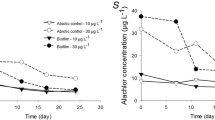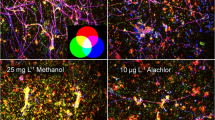Abstract
The potential of microbenthic algal assemblages to recover after diuron exposure was investigated. Microbenthic algal assemblages (periphyton) were grown on glass slides in correspondence to a diuron-polluted and a diuron-free sampling site of a river. After 5 weeks of colonization, the impacted periphyton was transferred by translocating the colonized glass slides to the unpolluted site. To monitor the changes in functional and structural parameters and to assess recovery, both the transferred and the local reference periphyton were sampled at the day of transfer (t0) and 1, 3, and 5 weeks after the transfer (t1, t3, t5). Structural transitions of eukaryotic communities were characterized by denaturing gradient gel electrophoresis (DGGE) and functional ones were characterized by short-term incubation toxicity tests with diuron. As shown by Bray–Curtis similarity values based on DGGE band patterns, almost total structural recovery of the transferred periphyton took place 5 weeks after transfer. For the transferred periphyton, previous diuron exposure at the contaminated site induced the development of diuron tolerance, which decreased after 1 week and became very similar to the tolerance of the nonimpacted community after 5 weeks. It is concluded that 5-week-old eukaryotic periphyton communities are capable of restoring their structural and functional attributes after 5 weeks within a noncontaminated environment.




Similar content being viewed by others
References
AFNOR (1982) Essais des eaux: Norme Française. NFT 90-023. AFNOR
Barranguet C, Plans M, van der Grinten E, Sinke JJ, Admiraal W (2002) Development of photosynthetic biofilms affected by dissolved and sorbed copper in a eutrophic river. Environ Toxicol Chem 21:1955–1965
Bérard A, Pelte T, Druart JC (1999) Seasonal variations in the sensitivity of Lake Geneva phytoplankton community structure to atrazine. Arch Hydrobiol 145:277–295
Biggs BJF (2000) New Zealand periphyton guideline: detecting, monitoring and managing enrichment of streams. Ministry for the Environment, New Zealand
Biondini ME, Bonham CD, Redente EF (1985) Secondary successional patterns in a sagebrush (Artemisia tridentata) community as they relate to soil disturbance and soil biological activity. Vegetatio 60:25–36
Blanck H (2002) A critical review of procedures and approaches used for assessing pollution-induced community tolerance (PICT) in biotic communities. Hum Ecol Risk Assess 8:1003–1034
Blanck H, Dahl B (1998) Recovery of marine periphyton communities around a Swedish marina after the ban of TBT use in antifouling paint. Marine Pollut Bull 36:437–442
Blanck H, Wänkberg SÅ, Molander S (1988) Pollution-induced community tolerance: a new ecotoxicological tool. In: Cairs J Jr, Pratt JR (eds) Functional testing of aquatic biota for estimating hazards of chemicals. STP 988. ASTM, Philadelphia, pp 219–230
Boivin ME, Massieux B, Breure AM, Greve GD, Rutgers M, Admiraal W (2006) Functional recovery of biofilm bacterial communities after copper exposure. Environ Pollut 140:239–246
Casamayor EO, Schäfer H, Bañeras L, Pedrós-Alió C, Muyzer G (2000) Identification of spatio-temporal differences between microbial assemblages from two neighboring sulfurous lakes: comparison by microscopy and denaturing gradient gel electrophoresis. Appl Environ Microbiol 66:499–508
Cattaneo A, Kerimian T, Roberge M, Marty J (1997) Periphyton distribution and abundance on substrata of different size along a gradient of stream trophy. Hydrobiologia 354:101–110
Dorigo U, Leboulanger C (2001) A pulse-amplitude modulated fluorescence-based method for assessing the effects of photosystem II herbicides on freshwater periphyton. J Appl Phycol 13:509–515
Dorigo U, Fontvieille D, Humbert JF (2006) Spatial variability in the dynamic and composition of the free-living bacterioplankton community in the pelagic zone of Lake Bourget (France). FEMS Microbiol Ecol 58:109–119
Dorigo U, Leboulanger C, Bérard A, Bouchez A, Humbert JF, Montuelle B (2007) Lotic biofilm community structure and pesticide tolerance along a contamination gradient in a vineyard area. Aquat Microb Ecol 50:91–102
Dorigo U, Lefranc M, Leboulanger C, Montuelle B, Humbert JF (2009) Spatial heterogeneity of periphytic microbial communities in a small pesticide-polluted river. FEMS Microbiol Ecol 67:491–501
Eulin A, Le Cohu R (1998) Epilithic diatom communities during the colonization of artificial substrates in the River Garonne (France). Comparison with natural communities. Arch Hybrobiol 143:76–106
Francoeur SN, Biggs BJF (2006) Short-term effects of elevated velocity and sediment abrasion on benthic algal communities. Hydrobiologia 561:59–69
Gouy V, Nivon C (2006) Protection des eaux en Beaujolais viticole: caractérisation et suivi de la qualité des eaux sur le bassin versant de la Morcille sur la période 2001–2005. Cemagref, Rapport final d’étude. Cemagref, Lyon
Guasch H, Ivorra N, Paulsson M, Montserrat R, Sabater S (1998) Community composition and sensitivity of periphyton to atrazine in flowing waters: the role of environmental factors. J Appl Phycol 10:203–213
Headley JV, Gandrass J, Kuballa J, Peru KM, Gong Y (1998) Rates of sorption and partitioning of contaminants in river biofilm. Environ Sci Technol 32:3968–3973
Hoagland KD, Roemer SC, Rosowski JR (1982) Colonization and community structure of two periphyton assemblages, with emphasis on the diatoms (Bacillariophyceae). Am J Bot 69:188–213
Iserentant R, Blancke D (1984) A transplantation experiment in running water to measure the response rate of diatoms to changes in water quality. In: Ricard M (ed) Proceedings of the 18th international diatom symposium, Paris. Koeltz Scientific Books, Koenigstein
Ivorra N, Hettelaar J, Tubbing GM, Kraak MH, Sabater S, Admiraal W (1999) Translocation of microbenthic algal assemblages used for in situ analysis of metal pollution in rivers. Arch Environ Contam Toxicol 37:19–28
Jurgensen TA, Hoagland KD (1990) Effects of short-term pulses of atrazine on attached algal communities in a small stream. Arch Environ Contam Toxicol 19:620–623
Knauer K, Leimgruber A, Hommen U, Knauert S (2010) Co-tolerance of phytoplankton communities to photosynthesis II inhibitors. Aquat Toxicol 96(4):256–263
McCune B, Mefford J (2006) PC-ORD. Multivariate analysis of ecological data, version 5.18. MjM Software, Gleneden Beach, OR
Molander S (1991) Detection, validity and specificity of pollution-induced community tolerance. PhD thesis, Department of Plant Physiology, Göteburg University, Sweden
Montuelle B, Dorigo U, Bérard A, Volat B, Bouchez A, Tlili A, Gouy V, Pesce S (2010) The periphyton as a multimetric bioindicator for assessing the impact of land use on rivers: an overview on the Ardières–Morcille experimental watershed (France). Hydrobiologia. doi:10.1007/s10750-010-0105-2
Morin S, Duong TT, Herlory O, Feurtet-Mazel A, Coste M (2008) Cadmium toxicity and bioaccumulation in freshwater biofilms. Arch Environ Contam Toxicol 54:173–186
Niemi GJ, Devore P, Detenbeck N, Taylor D, Lima A, Pastor J, Yount JD, Naiman RJ (1990) Overview of case studies on recovery of aquatic systems from disturbance. Environ Manag 14:571–587
Patil JS, Anil AC (2005) Quantification of diatoms in biofilms: standardisation of methods. Biofouling 21:181–188
Paule A, Lyautey E, Garabetian F, Rols JL (2009) Autogenic versus environmental control during development of river biofilm. Ann Limnol 45:1–10
Pesce S, Margoum C, Montuelle B (2010). In situ relationship between spatio-temporal variations in diuron concentrations and phototrophic biofilm tolerance in a contaminated river. Water Res. doi:10.1016/j.waters.2009.11.053
Porsbring T (2009) On toxicant-induced succession in periphyton communities: effects of single chemicals and chemical mixtures. Dissertation, University of Gothenburg
Rimet F (2009) Benthic diatom assemblages and their correspondence with ecoregional classifications: case study of rivers in north-eastern France. Hydrobiologia 636:137–151
Rimet F, Cauchie HM, Hoffmann L, Ector L (2005) Response of diatom indices to simulated water quality improvements in a river. J Appl Physicol 17:119–128
Sabater S, Gregory S, Sedell J (1998) Community dynamics and metabolism of benthic algae colonizing wood and rock substrata in a forest stream. J Phycol 34:561–567
Sabater S, Guasch H, Ricart M, Romani A, Vidal G, Klünder C, Schmitt-Jansen M (2007) Monitoring the effect of chemicals on biological communities. The biofilm as an interface. Anal Bioanal Chem 387:1425–1434
Schmitt-Jansen M, Altenburger R (2005a) Predicting and observing responses of algal communities to photosystem II-herbicide exposure using pollution-induced community tolerance and species-sensitivity distributions. Environ Toxicol Chem 24:304–312
Schmitt-Jansen M, Altenburger R (2005b) Toxic effects of isoproturon on periphyton communities: a microcosm study. Estuar Coast Shelf 62:539–545
Seguin F, Leboulanger C, Rimet F, Druart JC, Bérard A (2001) Effects of atrazine and nicosulfuron on phytoplankton in systems of increasing complexity. Arch Environ Contam Toxicol 40:198–208
Soininen J (2004) Assessing the current related heterogeneity and diversity patterns of benthic diatom communities in a turbid and clean water river. Aquat Ecol 38:495–501
Stevenson RJ (1990) Benthic algal dynamics in a stream during and after a spate. J N Am Benthol Soc 9:277–288
Stevenson RJ, Peterson CG, Kirschtel DB, King CC, Tuchman NC (1991) Density-dependent growth, ecological strategies, and effects of nutrients and shading on benthic diatom succession in streams. J Physicol 27:59–69
Tlili A, Dorigo U, Montuelle B, Margoum C, Carluer N, Gouy V, Bouchez A, Bérard A (2008) Responses of chronically contaminated biofilms to short pulses of diuron. An experimental study simulating flooding events in a small river running through a vineyard watershed. Aquat Toxicol 87:252–263
Tlili A, Bérard A, Roullier JL, Volat B, Montuelle B (2010) PO43− dependence of the tolerance of autotrophic and heterotrophic biofilm communities to copper and diuron. Aquat Toxicol. doi:10.1016/j.aquatox.2010.02.008
Tolcach ER, Gomez N (2002) The effect of translocation of microbenthic communities in a polluted lowland stream. Verh Int Ver Theor Limnol 28:254–258
Villeneuve A, Montuelle B, Bouchez A (2010) Influence of slight differences in environmental conditions (light, hydrodynamics) on the structure and function of the periphyton. Aquat Sci 72:33–44
Wellnitz T, Rader RB (2003) Mechanisms influencing community composition and succession in mountain stream periphyton: interactions between scouring history, grazing and irradiance. J N Am Benthol Soc 22:528–541
Xu FL, Jorgensen SE, Tao S (1999) Ecological indicators for assessing freshwater ecosystem health. Ecol Model 116:77–106
Zimba PV, Tucker CS, Mischke CC, Grimm CC (2002) Short-term effects of diuron on catfish pond ecology. N Am J Aquacult 64:16–23
Acknowledgments
The authors acknowledge B. Motte, and B. Volat for their support for field sampling and for their help in the laboratory. We also thank the Water Chemistry Laboratory of the CEMAGREF station in Lyon, which carried out nutrient and pesticide analyses in water. The project received funding from the national program ECOGER-PAPIER (AIP INRA) and was also supported by the LTER Zone Atelier du Bassin du Rhône (ZABR).
Author information
Authors and Affiliations
Corresponding author
Rights and permissions
About this article
Cite this article
Dorigo, U., Bérard, A., Bouchez, A. et al. Transplantation of Microbenthic Algal Assemblages to Assess Structural and Functional Recovery After Diuron Exposure. Arch Environ Contam Toxicol 59, 555–563 (2010). https://doi.org/10.1007/s00244-010-9511-8
Received:
Accepted:
Published:
Issue Date:
DOI: https://doi.org/10.1007/s00244-010-9511-8




